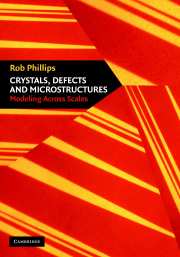Book contents
- Frontmatter
- Contents
- Preface
- Acknowledgements
- Notes on Units, Scales and Conventions
- Part One Thinking About the Material World
- 1 Idealizing Material Response
- 2 Continuum Mechanics Revisited
- 3 Quantum and Statistical Mechanics Revisited
- Part two Energetics of Crystalline Solids
- Part three Geometric Structures in Solids: Defects and Microstructures
- Part four Facing the Multiscale Challenge of Real Material Behavior
- References
- Index
1 - Idealizing Material Response
Published online by Cambridge University Press: 29 October 2009
- Frontmatter
- Contents
- Preface
- Acknowledgements
- Notes on Units, Scales and Conventions
- Part One Thinking About the Material World
- 1 Idealizing Material Response
- 2 Continuum Mechanics Revisited
- 3 Quantum and Statistical Mechanics Revisited
- Part two Energetics of Crystalline Solids
- Part three Geometric Structures in Solids: Defects and Microstructures
- Part four Facing the Multiscale Challenge of Real Material Behavior
- References
- Index
Summary
A Material World
Steel glows while being processed, aluminum does not. Red lasers are commonplace, while at the time of this writing, the drive to attain bright blue light is being hotly contested with the advent of a new generation of nitride materials. Whether we consider the metal and concrete structures that fill our cities or the optical fibers that link them, materials form the very backdrop against which our technological world unfolds. What is more, ingenious materials have been a central part of our increasing technological and scientific sophistication from the moment man took up tools in hand, playing a role in historic periods spanning from the Bronze Age to the Information Age.
From the heterostructures that make possible the use of exotic electronic states in optoelectronic devices to the application of shape memory alloys as filters for blood clots, the inception of novel materials is a central part of modern invention. While in the nineteenth century, invention was acknowledged through the celebrity of inventors like Nikola Tesla, it has become such a constant part of everyday life that inventors have been thrust into anonymity and we are faced daily with the temptation to forget to what incredible levels of advancement man's use of materials has been taken. Part of the challenge that attends these novel and sophisticated uses of materials is that of constructing reliable insights into the origins of the properties that make them attractive. The aim of the present chapter is to examine the intellectual constructs that have been put forth to characterize material response, and to take a first look at the types of models that have been advanced to explain this response.
- Type
- Chapter
- Information
- Crystals, Defects and MicrostructuresModeling Across Scales, pp. 3 - 28Publisher: Cambridge University PressPrint publication year: 2001



